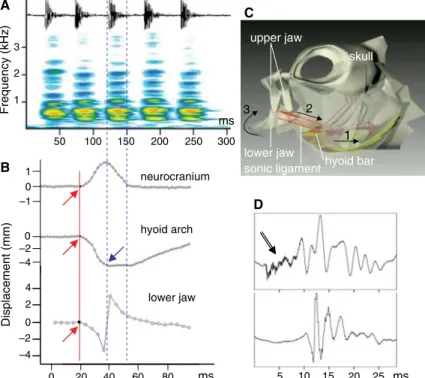Sound Production in the Clownfish
Amphiprion clarkii
Eric Parmentier,1* Orphal Colleye,1Michael L. Fine,2Bruno Frédérich,1 Pierre Vandewalle,1Anthony Herrel3
A
lthough clownfish sounds were recorded as early as 1930 (1), the mechanism of sound production has remained obscure. Yet, clownfish are prolific“singers” that produce a wide variety of sounds, described as “chirps” and “pops” in both reproductive and agonistic be-havioral contexts (2). Here, we describe the sonic mechanism of the clownfish Amphiprion clarkii.
We studied sounds (from three males and one female) di-rected toward conspecifics that approach their sea-anemone hosts. Sound recordings, syn-chronized with high-speed video (500 fps) coupled (n = 9) or not (n = 22) with an x-ray system, allowed us to quantify move-ments of skeletal elemove-ments (3). A. clarkii sounds (Fig. 1) are produced in trains of one to eight pulses (means for duration, 26 ms; pulse period, 35 ms; and energy, between about 450 to 800 Hz). These parameters do not correspond with typical stridulatory mech-anisms (4) and have higher frequency components than swimbladder sounds driven as a forced response to sonic muscle contraction (5).
Sounds (n = 14) were typ-ically accompanied by rapid (<30 ms) movements that in-clude an elevation of the head, lowering of the hyoid bar and
anterior part of the branchial basket, a backward movement of the pectoral girdle, and lastly a closing of the lower jaws (movie S1). Syn-chronization of sound pulses with the video images indicates that sound is produced when the hyoid apparatus is rapidly lowered (23.8 m/s2, n = 50 frames) and the mouth simultaneously closed (Fig. 1).
Manipulations of specimens show that low-amplitude elevations of the skull lower the jaws and branchial basket, a phenome-non well known in fish feeding (3, 6). Rather than accentuating this movement, a
higher-amplitude elevation of the head actually forces the mouth to close by a previously unknown mechanism.
Dissections reveal that an unusual sonic ligament is responsible for the rapid lower jaw elevation. The ligament joins the hyoid bar (ceratohyal) to the internal part of the mandible (coronoid process of the articulo-angular) and can be compared to a drawbridge (movie S2). The ligament, acting as a cord, forces the man-dible to turn around its articulation during the lowering of the hyoid bar, forcing the mouth to close (Fig. 1). Sound results from the collisions of the jaw teeth, transferring energy to the jaws that are presumably the sound radiator. Transect-ing the right and left sonic ligaments muted the
fish, supporting our hypothesis. Furthermore, cutting upper and lower jaw teeth resulted in shorter sounds (23 versus 48 ms,P < 0.0001, n = 38 pulses) without the typical low-amplitude high-frequency onset. This result indicates that intact sounds start with teeth collisions (Fig. 1).
Species-specific sounds are produced by all
27 Amphiprion species and appear to be
supported at least by interspecific variation in teeth shape. The sonic ligament is present in other members of the damselfish family (7), many of whom produce communication sounds (8). The homologous ligament mechanism is likely involved in sound pro-duction throughout this large family and represents a novel skeletal adaptation for a new behavioral function. This func-tional movement seems to be an exaptation of the feeding mechanism.
References and Notes
1. J. Verwey, Treubia 12, 305 (1930). 2. E. Parmentier, J. P. Lagardère,
P. Vandewalle, M. L. Fine, Proc. R. Soc. London Ser. B 272, 1697 (2005).
3. S. Van Wassenbergh, A. Herrel, D. Adriaens, P. Aerts, J. Exp. Biol. 208, 4627 (2005).
4. W. N. Tavolga, in Fish Physiology, W. S. Hoar, D. J. Randall, Eds. (Academic Press, New York, 1971), vol. 5, pp. 135–205. 5. F. Ladich, M. L. Fine, in
Communication in Fishes, F. Ladich, S. P. Collin, P. Moller, B. G. Kapoor, Eds. (Science Publishers, Enfield, NH, 2006), pp. 3–43.
6. J. Osse, Neth. J. Zool. 19, 290 (1969). 7. M. L. J. Stiassny, J. S. Jensen, Bull.
Mus. Comp. Zool. Harv. Univ. 151, 269 (1987).
8. D. A. Mann, P. S. Lobel, J. Acoust. Soc. Am. 101, 3783 (1997). 9. E.P. is a Scientific Research
Worker in Fonds National de la Recherche Scientifique. We thank P. Morinière (Aquarium of La Rochelle, France) and D. Barthélemy (Oceanopolis, Brest, France) for kindly giving living specimens of A. clarkii.
Supporting Online Material
www.sciencemag.org/cgi/content/full/316/5827/1006/DC1 Movies S1 and S2
10 January 2007; accepted 9 February 2007 10.1126/science.1139753
BREVIA
1
Laboratoire de Morphologie Fonctionnelle et Evolutive, Institut de Chimie, Bâtiment B6, Université de Liège, B-4000 Liège, Belgique.2Department of Biology, Virginia Commonwealth
University, Richmond, VA 23284–2012, USA.3Laboratory for
Functional Morphology, Department of Biology, Building C, University of Antwerp, Campus“Drie Eiken,” Universiteitsplein 1, 2610 Antwerpen, Belgium.
*To whom correspondence should be addressed. E-mail: E.Parmentier@ulg.ac.be 50 100 150 200 250 300 1 2 3 0 1 –1 0 –2 –4 neurocranium hyoid arch 20 0 40 60 0 –2 –4 2 4 lower jaw Displacement (mm) Frequency (kHz) 5 10 15 20 25 A B D C sonic ligament skull lower jaw upper jaw hyoid bar 1 2 3 80 ms ms ms
Fig. 1. Sound production in A. clarkii. (A) Oscillogram and sonagram of a train of pulses. (B) Graphs of the movements of different skeletal elements during sound production. The red line indicates the beginning of the sonic movement; the blue arrow, the pulse onset; and double dotted lines, the sound duration. (C) Schematic representation of the sound-producing mechanism, illustrating the relative movement of skeletal components. Lowering the hyoid bar (1) stretches the sonic ligament (2), and the jaw closes the mouth (3) by rotating around the mandible articulation on the quadrate. See also movies S1 and S2. (D) Oscillogram of a pulse. Top selection is sound from an intact fish; bottom selection, sound from the same fish after the jaw teeth were cut. The bottom pulse is shorter and deprived of the high-frequency onset (arrow).
18 MAY 2007 VOL 316 SCIENCE www.sciencemag.org
1006
